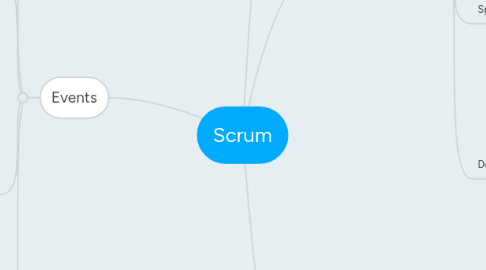
1. Events
1.1. Daily Scrum
1.1.1. Standup
1.1.2. No discussions
1.1.3. No management attending
1.1.4. Synchronize work
1.1.5. Template
1.1.5.1. What have you done yesterday?
1.1.5.2. What are you going to do today?
1.1.5.3. Are there any impediments?
1.2. Sprint Planning
1.2.1. 4-8 hours
1.2.2. What can be done this Sprint?
1.2.3. How the work will be achieved?
1.2.4. Backlog must me refined prior to the meeting
1.2.5. PO helps clarifying items
1.3. Sprint Review
1.3.1. Review/demo to stakeholders
1.3.2. Product Inspection and Adaptation
1.3.3. Feedback for next Sprint
1.3.4. Steps
1.3.4.1. PO explain what is done and what is not
1.3.4.2. Dev Team discusses how the Sprint was
1.3.4.3. Demonstration
1.3.4.4. PO discusses Backlog
1.3.4.5. What do to next?
1.4. Sprint Retrospective
1.4.1. 1.5-3 hours
1.4.2. Inspect and adapt the process
1.4.3. Last Sprint
1.4.3.1. People
1.4.3.2. Process
1.4.3.3. Technologies
1.4.4. Indentify items for improvement
1.4.5. Create a plan
2. Sprint
2.1. Timeboxed
2.1.1. 1-4 weeks
2.2. Sprint Goal
2.3. No time between Sprints
2.4. Produces a potencially shippable increment
2.5. No changes made to endanger the Goal
2.6. Quality goals do not decrease
2.7. Scope may be clarified or negotiated with the PO
2.8. Cancelling
2.8.1. Only the PO
2.8.2. Uncommon and traumatic
2.8.3. When the Goal becomes obsolete
3. Artifacts
3.1. Product Backlog
3.1.1. Product Requirements
3.1.2. 10% of Sprint spent refining it
3.1.3. DEEP
3.1.3.1. Detailed appropriately
3.1.3.2. Estimated
3.1.3.3. Emergent
3.1.3.3.1. Evolves
3.1.3.3.2. Never complete
3.1.3.4. Prioritized
3.1.3.4.1. High-value high-risk
3.1.3.4.2. High-value low-risk
3.1.3.4.3. Low-value low-risk
3.1.3.4.4. Low-value high-risk
3.2. Sprint Backlog
3.2.1. Product Backlog subset selected for the iteration
3.2.2. Only the Development Team can change it
3.2.3. Plan for delivering the increment
3.3. Definition of Done
3.3.1. Common understanding of what Done means
3.3.2. Checklist
3.3.3. Defined by the team
3.3.3.1. Quality criterias
3.3.4. Normally defined for...
3.3.4.1. Item
3.3.4.2. Sprint
3.3.4.3. Release
4. Roles
4.1. ScrumMaster
4.1.1. Facilitator
4.1.1.1. Events and meetings
4.1.2. Coach
4.1.2.1. Technical practices
4.1.2.2. Self-organization
4.1.2.3. Cross-functionality
4.1.2.4. Make stakeholders understand Scrum
4.1.3. Enforces adoption
4.1.3.1. Scrum
4.1.3.2. Agile
4.1.4. Techniques for improvement and management
4.2. Product Owner
4.2.1. Product authority / decisions
4.2.2. Express PBI
4.2.3. Prioritization
4.2.4. Value optimization
4.2.5. Ensure Backlog is
4.2.5.1. Visible
4.2.5.2. Transparent
4.2.5.3. Clear to everyone
4.2.6. Organization must respect his decisions
4.3. Development Team
4.3.1. Self-organizing
4.3.2. Cross-functional
4.3.3. 7 +/- 2
4.3.4. No titles
4.3.5. No subteams
4.3.6. Accountability to the whole
